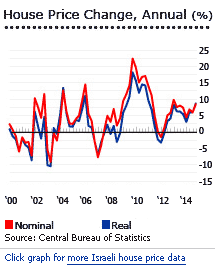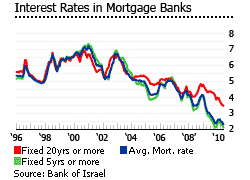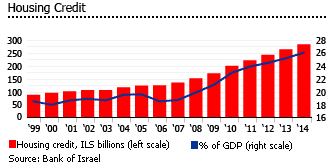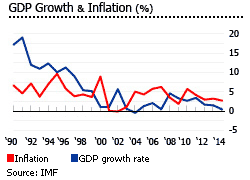Israeli house prices rising faster and faster
 The average price of owner-occupied dwellings in Israel rose by 8.45% during 2014, to ILS 1,352,800 (US$ 349,379). House-price growth picked up strongly from earlier price rises of 5.94% year-on-year (y-o-y) to Q3, 6.84% to Q2, and 4.42% to Q1, according to the Central Bureau of Statistics (CBS).
The average price of owner-occupied dwellings in Israel rose by 8.45% during 2014, to ILS 1,352,800 (US$ 349,379). House-price growth picked up strongly from earlier price rises of 5.94% year-on-year (y-o-y) to Q3, 6.84% to Q2, and 4.42% to Q1, according to the Central Bureau of Statistics (CBS).
When adjusted for inflation, house prices rose by 8.66% in 2014. On a quarterly basis, nationwide house prices rose by 2% (2.1% in real terms) during the latest quarter, Q4 2014.
Gush Dan saw the highest house price increase during the year to Q4 2014, with prices rising by 14.69%. It was followed by the Southern district (13.81%), Sharon (10.98%), Tel Aviv (10.19%), and the Center and Jerusalem Periphery Towns (9.26%).
Other districts such as the Northern district and Jerusalem also experienced moderate year-on-year house price growth of 6.5% and 6%, respectively. Meanwhile, house prices in Qrayot Haifa (3.55%) and Haifa (2.31%) had relatively smaller increases, compared to other districts.
The country’s most expensive housing can be found in Tel Aviv, with an average price of owner-occupied dwellings of ILS 2,480,800 (US$ 640,701) in Q4 2014. It was followed by Jerusalem at ILS 1,712,700 (US$ 442,329) and Sharon at ILS 1,694,600 (US$ 437,654).
Israel experienced dramatic house prices rises in 2009 and 2010, despite domestic political uncertainty, security threats, and the global financial meltdown. The housing market returned to robust growth in 2012 and 2013.
- The average price of owner-occupied dwellings rose modestly by 4.1% (-0.49% inflation-adjusted) in 2008
- Property prices rose by 22.35% (18.15% inflation-adjusted) in 2009
- Property prices rose by 17.04% (14.22% inflation-adjusted) in 2010
- Property prices rose by just 0.04% (-2.39% inflation-adjusted) in 2011
- Property prices rose by 5.82% (4.12% inflation-adjusted) in 2012
- The average price of owner-occupied dwellings rose by 7.38% (5.43% inflation-adjusted) in 2013.
Demand is starting to pick up after declining in 2014. In March 2015, the total number of dwellings sold rose by 34.3% y-o-y to 2,478 units. In 2014, the total number of new dwellings sold was 22,492, down by 9.9% from a year earlier. Similarly, the total quantity demanded also fell by 8.8% y-o-y to 40,728 units in 2014. The decline was attributed to the announcement of a 0% VAT plan by then Finance Minister Yair Lapid in March 2014, designed to exempt first-time home buyers from the 18% VAT. Globes reported that the announcement led to many frozen deals and to a sharp decline in new home purchases.
However, Prime Minister Benjamin Netanyahu suspended further discussion of the 0% VAT plan in early September 2014 and demanded that Lapid freeze the bill. The following day, December 2, 2014, PM Netanyahu fired Lapid from his post as Finance Minister, along with Justice Minister Tzipi Livni.
The total number of dwelling completions rose by 49.1% y-o-y In February 2015 to 4,415 units, according to the CBS. In contrast, dwelling starts fell by 5.9% y-o-y to 3,947 units in February 2015.
Recent history: house price rises cause social protests
The global house-price crisis missed Israel. From Q1 2010 to Q2 2011 average house prices rose almost 13%. One result was a social protest movement, which began in July 2011 with a Facebook group protesting Israel´s rising cost of living (specifically housing costs) as well the worsening condition of public services.
The central bank then raised the benchmark rate four times as the Israeli economy recovered from the global crisis to 1.5% in April 2010. Then in August 2010 the key rate was again raised to 1.75%, in a move to cool Israeli house prices and prevent a housing bubble. CBI rate hikes continued until the key rate reached 3.25% in June 2011.
House price rises therefore slowed during the second half of 2011. House price growth was only 0.5% between Q3 2011 and Q1 2012. The districts of Tel Aviv (-3.1%), Sharon (-2.9%), Gush Dan (2.3%), and Jerusalem (-1.2%) actually experienced house price declines.
In Q2 2012 house prices started to rise again and have been moving upward ever since. House prices rose by 19.7% from Q2 2012 to Q4 2014, with Gush Dan (27.6%) and Tel Aviv (25.9%) leading the price surge.
CHANGES IN AVERAGE PRICE OF DWELLINGS (%) |
||||||||
|
Second Intifada (Q3 00 - Q2 03) | (Q2 03 - Q1 06) | Israel - Hezbollah War (Q1 - Q4 2006) | (Q4 06 – Q4 07) | Global economic crisis (Q1 2008 – Q4 2009) | (Q1 10 - Q2 11) | Israeli social justice protests (Q3 11 - Q1 12) | (Q2 12 - Q4 14) |
| Israel | -6.47 | 28.09 | -11.60 | 4.90 | 24.20 | 12.99 | 0.53 | 19.71 |
| Districts | ||||||||
| Tel Aviv | -16.60 | 25.50 | -12.60 | 22.37 | 41.27 | 8.26 | -3.06 | 25.92 |
| Center | 6.77 | 10.21 | -12.12 | 16.22 | 34.61 | 20.34 | 0.21 | 18.93 |
| Southern | 11.96 | -0.78 | 8.93 | 6.84 | 29.10 | 15.26 | 2.77 | 24.12 |
| Jerusalem | -3.86 | 36.77 | -6.05 | 5.05 | 20.13 | 14.23 | -1.22 | 12.94 |
| Northern | 1.57 | 0.07 | -8.00 | -4.40 | 4.66 | 51.46 | 5.13 | 24.75 |
| Haifa | -10.34 | -0.68 | -10.26 | -8.47 | 29.85 | 23.54 | 9.82 | 21.98 |
| Metropolitan Areas | ||||||||
| Sharon | 1.81 | 26.25 | -10.08 | 9.33 | 32.91 | 9.33 | -2.93 | 20.23 |
| Gush Dan | -2.24 | 5.22 | -5.70 | 5.80 | 33.08 | 10.97 | -2.26 | 27.61 |
| Qrayot Haifa | 6.15 | -6.26 | -2.81 | -10.51 | 18.33 | 25.40 | 13.93 | 13.65 |
| Source: Central Bureau of Statistics | ||||||||
History: Israeli house prices and conflict
Israeli house prices seem to be affected by periods of conflict with Israel´s neighbours. House prices rose 28% (25.8% in real terms) between Q2-2003 and Q1-2006, due to the economic stability brought by the success of the electronics industry, investments and financial aid from the US, by inward investment, and by the improved security situation.
The war between Israel and Hezbollah, which erupted in July 2006, however rocked an already volatile political environment. Consumer and investor confidence dropped. Both supply and demand for housing fell.
The average price of houses fell 11.6% from the peak level of ILS 793,800 (US$205,488) in Q1 2006 to ILS 701,700 (US$181,646) in Q4 2006. Although the war formally ended in August 2006, the lingering uncertainty over the peace and order situation led to weakness in the housing market.
During 2007, the housing market recovered slightly with 4.9% y-o-y price increase (2.1% in real terms). However, the recovery was interrupted by the rising tensions with Iran and with the Hamas-controlled Gaza Strip. Israel’s continued expansion of Jewish settlements in East Jerusalem and in the West Bank also increased tension.
Tel Aviv’s housing market suffers the most whenever the country is in conflict. With the Israel-Hezbollah war, house prices fell 12.6% from Q1 to Q4 2006. In contrast, the Southern district, relatively unscathed by the conflict, registered an 8.9% price increase over the same period.
Property prices in other districts have partially recovered since the cessation of conflict at the end of 2006. Surprisingly, Tel Aviv recorded the highest house price rise of 22.37% y-o-y in 2007. The national average price also rose by 4.9% over the same period.
Despite the global crisis, Israel enjoyed double-digit house price rises. The highest house price increase was recorded in Tel Aviv, at 41% between Q1 2008 to Q4 2009. Only the Northern district registered a single-digit house price growth of 4.7%. The average price in Israel rose 24.2% between Q1 2008 to Q4 2009.
Affordable housing in short supply

Dwelling completions for the first two months of 2015 totaled 7,573 units, up by almost 10% from the same period last year, according to the CBS. In 2014, dwelling completions rose by 5.2% to 44,885 units from the previous year. Around 84% of the total completions, or about 37,803 units, came from the private sector.
In contrast to the rising completions, the recent figures of dwelling starts look dismal. From January to February 2015, total dwelling starts were at 8,246 units, a 5.9% decline from the same period last year, according to the CBS. In 2014, there were a total of 43,751 housing starts, a 7.7% drop from 2013. About 34,127 units, or 78% of the total dwelling starts were from the private sector.
Mortgage interest rates at historic lows

Mortgage interest rates in Israel are still low. In March 2015, the average mortgage interest rate in Israel was 2.12%, slightly lower than 2.34% in March 2014 and way below the 6.7% rate in January 2013.
To moderate the effect of the global crisis on the country’s economic growth, the central bank cut the key rate by a total of 375 basis points from October 2008 to April 2009, till it hit a record low of 0.5% in April 2009. But Israel was in fact less affected by the crisis than expected and by June 2011 key rates were back up to 3.25%.
In October 2011 the rate hikes stopped, and instead, the BOI lowered the key interest rate to 3.03%. It was the beginning of the continuous rate cuts over the succeeding years. The BOI´s most recent cut was in March 2015 when the key rate was cut to 0.1%, down from the previous rate of 0.25%. The rate reduction was in line with the bank’s intention to return the inflation rate within the 1-3% target, as well as to “support growth while maintaining financial stability”.
Is Israel´s financial stability under threat from high house prices?

Some say Israel´s sky-high housing market is a threat to financial stability, but the signs are reassuring. Though mortgage interest rates have generally declined since 2003, the mortgage market has expanded less than expected and was only around 26.1% of GDP in 2014, up from 18% of GDP in 2000. This is a modest level of borrowing in a developed country.
And despite the fact that by end- 2013 housing debt constituted around 70% of total household debt, households in Israel still have a large surplus of assets over liabilities. The ratio of total liabilities to total assets among Israeli households was about 8% in 2012 as compared to 16% in the UK and the US, according to the BOI.
Another good sign: in early 2014, unindexed variable-interest rate mortgages were only 36% of the banks’ total balance of mortgages, down from 77% of new mortgages in February 2009.
Nevertheless the BOI´s Supervisor of Banks has actively intervened to reduce system risk:
- Variable-rate loans were limited from mid-2011;
- The LTV ratio was limited towards end of 2012;
- Capital adequacy and group allowances for doubtful debt were raised in early 2013;
- The PTI (Payment-to-income) ratio was also reduced in mid-2013.
Poor yields in Tel Aviv - a tax hike may lower them still further
Gross rental yields on apartments in Tel Aviv are very low, supporting the view that properties are somewhat overpriced. Yields are under the 3% mark based on the Global Property Guide research in August 2014, ranging from 2.28% to 2.95%, with smaller apartments having higher yields.
By the end of 2014, the average monthly rent in the country had risen by 4.43% from the previous year to ILS 3,749 (US$ 969) per month. The most expensive rents can be found in Tel Aviv, with an average monthly apartment rent of ILS 5,746 (US$ 1,486) in Q4 2014, 53.27% above the national average. In Jerusalem, apartments rent at an average of ILS 4,072 (US$ 1,053) per month.
The Finance Ministry recently proposed to Minister of Finance-designate Moshe Kahlon a 20% purchase tax increase on housing for investment purposes, to discourage potential investors from buying rental apartments by making them less profitable. That way more apartments will be available for people who want to buy with the intention of occupying the property, since the tax wouldn’t apply to them. Kahlon appears to favour the proposal.
In the past 15 years, the homeownership rate in the country has been gradually declining as more households are renting due to the shortage of affordable housing. In 2008, the homeownership rate was 68.8%, down from 73% in 1995.
Though around 10,500 apartments were sold in March, 11% up from the previous month (Beersheva sales excluded) according to Globes reporting of Ministry of Finance statistics, the purchase of apartments by investors has generally been cooling off. On the other hand, says the Ministry of Finance, "since the beginning of 2015 there has been a high number, compared to recent years, of investors buying more than one apartment for investment over the past decade."
Healthy economic outlook for 2015
Israel´s economy performed well during the last quarter of 2014, with annualized real GDP growth of 6.8%, way up on 0.2% the previous quarter, 1.7% in Q2 2014, and 3% in Q1 2014, according to the CBS:
In Q4 2014:
- Private consumption was strong, rising by 7.9% y-o-y.
- Government consumption rose by 8.5%.
- Exports surged by 12.7%, following meagre growth of 1.3% the previous quarter, while imports contracted by 2.9%.
Israel’s economy expanded by 2.8% during the whole year of 2014, a slowdown from the previous years’ expansion of 3.2% in 2013, 3% in 2012, 4.2% in 2011, and 5.7% in 2010, according to the IMF. The slowdown was partly due to the Operation Protective Edge launched by Israel in July 2014, which aimed to stop rocket fire from Gaza Strip to Israel. The operation lasted for more than one and a half month. Both parties accepted a cease-fire on August 26, 2014.

The Bank of Israel expects 3.2% GDP expansion in 2015 and around 3.5% in 2016.
In March 2015, the country’s unemployment rate was 5.3%, according to CBS. Despite the economic slowdown in 2014, unemployment fell to 5.9% from around 6.2% in 2013.
Inflation was -1% in March and February 2015, down from -0.5% inflation in January 2015, according to the CBS. In 2014, the country’s budget deficit was around 2.8% of GDP.
The BOI’s target of 1-3% inflation is seemingly unattainable this year as the central bank’s research department predicts -0.1% inflation in 2015. The target is only expected to be reached in 2016, when inflation is predicted to rise to 1.7%.
Prime Minister Benjamin Netanyahu, of the Likud party, retained his post as Israel’s prime minister after winning the latest legislative election last March 2015. Likud won 30 seats, while the opposition Zionist Union came second, nabbing 24 seats.
Likud’s win came as a surprise since it had trailed behind the Zionist Union in pre-election polls prompting PM Netanyahu to state that a Palestinian state will not be established during his term (if he remained in power), in an interview published by the daily Maariv newspaper before the March 17 elections. This statement, though now retracted, and Netanyahu’s return to power, puts Israel in a difficult position in relation to the US and the international community´s support for the establishment of a Palestinian state in East Jerusalem, the Gaza Strip, and the West Bank.